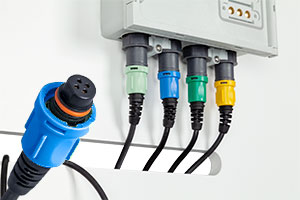11/5/2024
| Dr. Patrick Wolf
Oxygen is not the most common parameter in continuous drinking water monitoring – although the right measurement technology hardly creates any additional work.
Oxygen in drinking water treatment
 The mg/L concentration of dissolved oxygen is one of the indicator parameters used to monitor drinking water. In addition, the measurement is often used to determine the oxygen content of raw water. If this is oxygen-starved groundwater, oxygen must be added to oxidize bivalent iron to trivalent iron so that it can be filtered out later. Furthermore, the oxygen promotes the colonization of bacteria, with the help of which manganese and ammonium are oxidized.
The mg/L concentration of dissolved oxygen is one of the indicator parameters used to monitor drinking water. In addition, the measurement is often used to determine the oxygen content of raw water. If this is oxygen-starved groundwater, oxygen must be added to oxidize bivalent iron to trivalent iron so that it can be filtered out later. Furthermore, the oxygen promotes the colonization of bacteria, with the help of which manganese and ammonium are oxidized.
Optical sensors with fixed cable or with plug-in head
The IDS-Sensor FDO® 925 IDS sensor FDO® 925 is available for operation on the drinking water panel. The calibration-free sensor can be connected as a fixed cable version (order number 201300 or 201301) or as a plug-in head version (order number 201306). As all maintenance work can carried out directly on the drinking water panel and therefore conveniently at the measuring point, we recommend using the shortest possible cable length in all cases. However, longer cables are also available for individual installations.

IDS sensors on the IQ Sensor Net; front: bayonet catch of the IDS cable (blue – for oxygen sensors)
Installation and commissioning in 3 steps
Step 1: Cable connection
The connection of the cable to the converter is identical for both the fixed cable and the plug-in head version. The cable is connected to the cable socket with the flat section facing backwards and secured with a bayonet catch. With a plug-in head version, the cable must also be connected to the sensor. Correct positioning is ensured by a guide and a snap lock guarantees a reliable connection. As the sensor is automatically detected by the device, no parameterization is required.

Left: Installation of the FDO® 925 with sensor cap to the front; right: installed FDO® 925 with spacer
Step 2: Installation in the flow cell
- Angled surface of the sensor cap towards the front for optimum flow and reliable results
- Use spacer to position the sensor cap correctly
- Tighten the PG closure by hand
Step 3: Stow the cable
Now guide the excess cable through the gap to the rear. This not only creates a clean and tidy appearance, (great for guided tours with visitors), but also without a myriad of tangled cables, maintenance work is much easier.
Maintenance
Depending on the area of application or the specifications of the operator or manufacturer, sensors are checked or cleaned at regular intervals. This maintenance interval is often 6–8 weeks. The sensor itself demands barely any work – especially at the transfer point to the drinking water network.
Calibration
The sensor is calibrated at the factory and does not require further calibration due to its inherent stability. This saves time and work. If desired (due to company policy for instance), the sensor can of course be calibrated – whether directly on the Drinking Water Panel or on a handheld device or benchtop.
Sensor check
It makes sense to check the sensor if the measured values appear implausible or as part of operational quality assurance. The test is carried out on water vapor-saturated air; the test vessel supplied with the sensor can be used for this purpose. The procedure takes about 5 minutes and consists of 4 steps (see box):
Cleaning
The following points should be noted:
- Hold the sensor cap by the side, not by the membrane
- Avoid mechanical stress
- Do not expose the inside of the sensor cap to daylight unnecessarily
- Rinse sensor with tap water
- Remove deposits on the shaft with a soft brush; not on the membrane
- Wipe the sensor cap and membrane with a damp soft microfiber cloth
- For stubborn dirt, add a little household washing-up liquid to the tap water
- Do not use alcohols for cleaning
Cap change
Based on previous experience, the service life of the sensor cap is at least 1 year with continuous use. Please note when changing the cap:
- Please refer to the previous section “Cleaning”
- Additionally for cap change:
- Ensure a dry and clean working environment
- Only store removed sensor caps in a light-protected environment

You may also be interested in these blog articles:
Products for the dissolved oxygen measurement in drinking water and other areas of application (a selection):